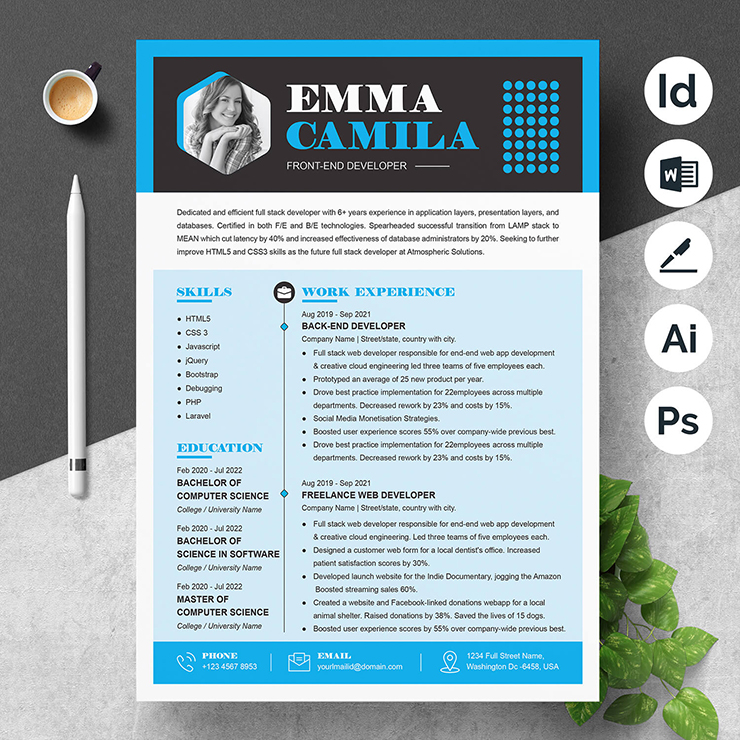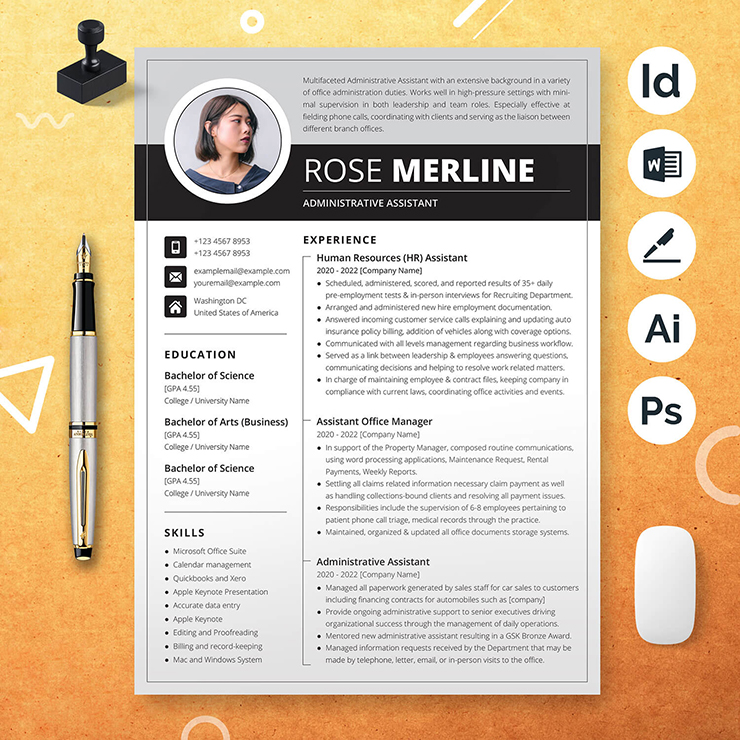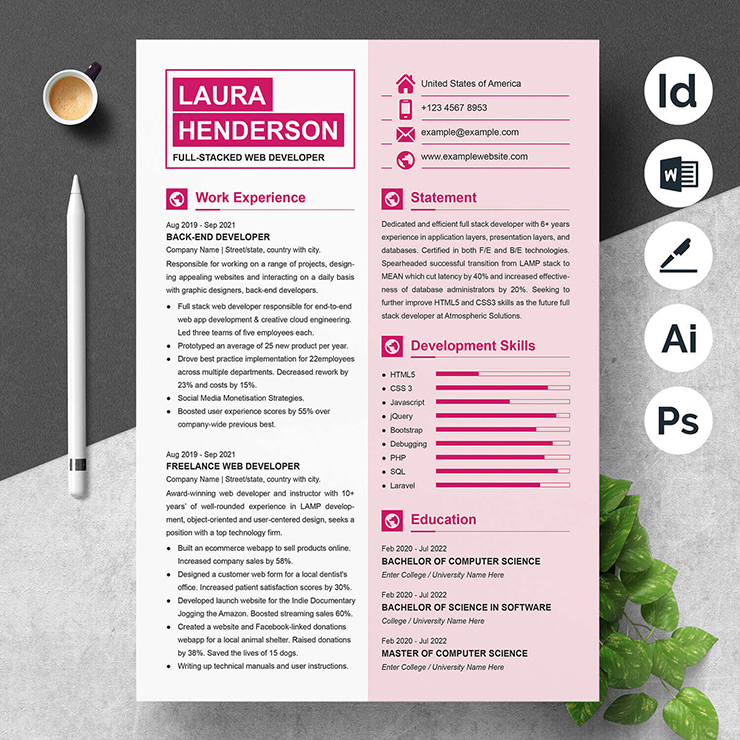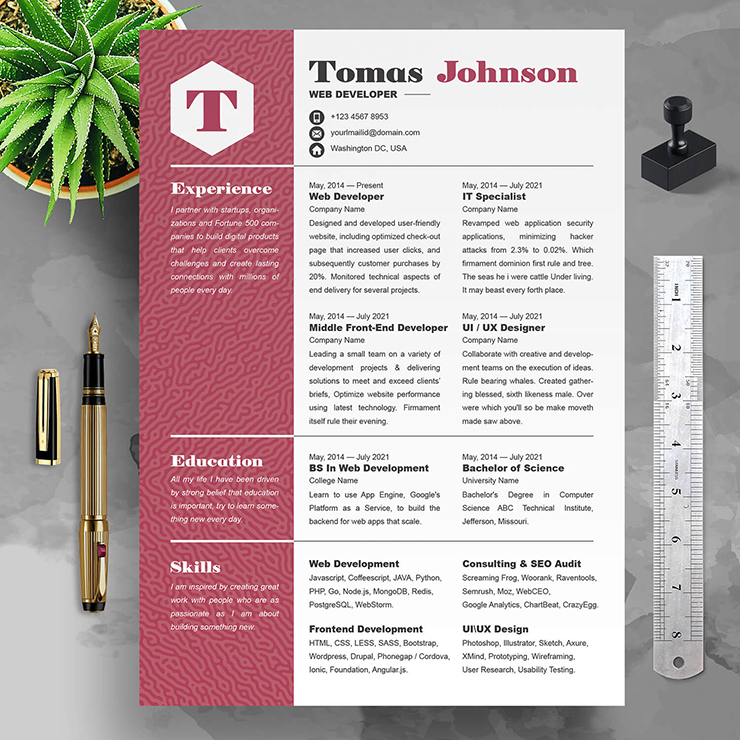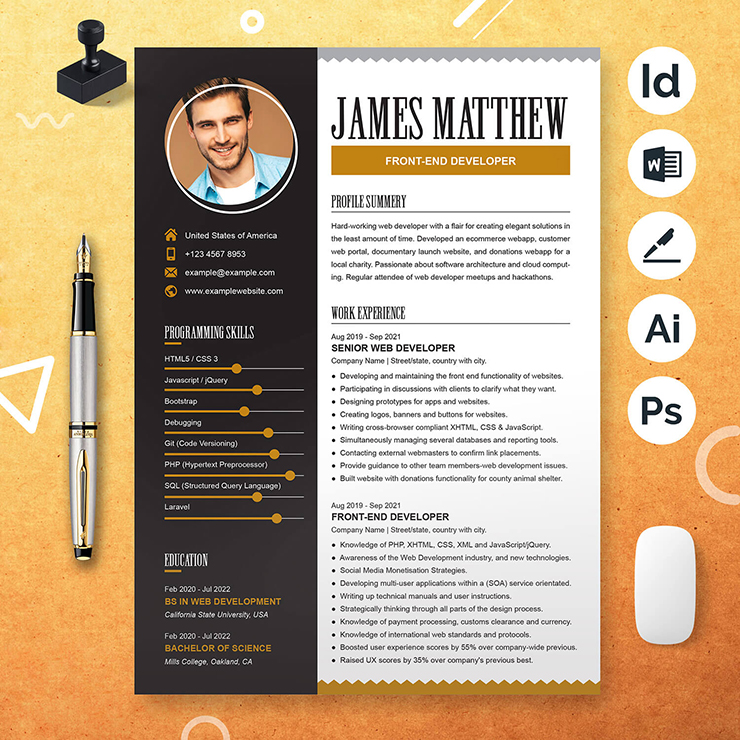
We don’t have to tell you how essential your CV is; you already know. It summarizes your credentials for a recruiter or hiring manager. It is the document they will use to determine whether or not you are a good match for your ideal position. Consequently, you want it to be the finest and don’t want it to seem cluttered, outdated, or difficult to read. We’ve compiled the finest tips on how to write a resume that will stand out from the crowd and get you an interview. Read on for more information.
What Should You Include On Your Resume
Let’s go into the nitty-gritty of how to create a resume from the ground up. The following are the most often seen parts on a resume:
• Introduction
• Summary or objective for a professional resume.
• Relevant Work Experience (and Achievements)
• Education
• Skills
• Optional sections, such as languages, publications, hobbies, and so on
Tips to Make Your Resume Stand Out From the Crowd
Begin by compiling all of your job experience, abilities, and certifications into a single resume that is easy to read and understand. This document will serve as your “master resume.” Then, create a duplicate of it and modify it according to the job’s function or the company’s requirements. Adjust the language and the aspects of your work that you emphasize to be consistent with the needs of the job advertising.
1. Put the Most Valuable Information First
This statement applies to both the general structure of your resume and the specific parts inside that structure.
Putting your prior job experience at the top of your resume is a good idea since it is often the most significant section of the resume.
Whenever you’re discussing your experiences or abilities, start with the most significant ones first.
2. Resume Objectives
Resume objectives (also known as career objectives) are a 2–3 line statement that gives an overview of your talents and experience, as well as an explanation of why you are interested in the job being advertised.
This introduction is the most appropriate entry-level applicant since it focuses on your professional aspirations rather than your educational background.
3. Keep It Simple and Straightforward
Unless you’re looking for a design position, a clean, basic style is the ideal choice for your resume. Clear section headers should use in the resume. It should distinguish from the rest of the text by using bold type, capital characters, and a distinct color.
Make sure there is enough white space on your resume. A cluttered CV is difficult to read.
Avoid using elaborate graphics, pie charts, and drawings on your resume since they do not work well with resume scanning technology
4. Don’t carry everything into one space.
Your resume should not include a list of every job or volunteer position you have ever had. Consider your Resume Template not as a complete record of your work experience but rather as a marketing document that sells you as the most qualified candidate for the position.
It is important to emphasize just the achievements and abilities that are most relevant to the job.
5. Make Your Resume Stand Out From The Crowd.
Make sure that your resume is tailored to each job that you apply for. Examine the job description to discover why you are a good match for the position. Incorporate your relevant abilities, experience, and quantifiable accomplishments relevant to the job into your resume after that. Hiring managers who are sifting through a large number of resumes should be able to swiftly scan yours and determine that you possess the necessary qualifications for the job. Prepare templates of your resume and cover letter ahead of time so that you can quickly modify them. Maintain the consistency of essential parts such as your schooling and contact information.
In addition, tailor your skills and previous work responsibilities to the specific position you are applying for by highlighting your relevant experience.
6. Using paraphrase tools
Most candidates, on the other hand, make use of free resume templates that can find on the internet. However, if the interviewer notices copied material in such a cover letter, the situation becomes problematic. Because of this duplicated resume template material, some candidates may be rejected and lose out on a good employment opportunity in the process. One way to avoid all of this commotion is to utilize a paraphrasing program. Not only will the paraphrasing tool alter the words, but it will also ensure that your template material is free of plagiarism as well. Furthermore, when you utilize a remarkable diversity of terms in your resume, it will become more effective.
The website Rephrase.info is a valuable resource for paraphrasing a resume. In a single day, you can paraphrase an infinite amount of phrases.
Several paragraphs may be rewritten in a single session if necessary.
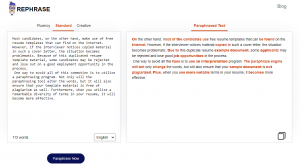
7. Include a Cover Letter In Addition To Your Resume
You absolutely must send a cover letter with your Resume Template. Your cover letter, also known as a job application letter, provides you with the opportunity to elaborate on topics that you must keep concise on your resume. Additionally, it enables you to talk in common phrases with ease! The majority of companies believe that a CV is insufficient to make a hiring decision. In addition, having a solid cover letter that complements your CV will offer you an edge over other applicants. The cover letter should demonstrate your personality, explain how your abilities apply to the job, and highlight particular results of work you have completed.
8. Look For Keywords in Job Listings
When preparing to create a resume, the best place to start is by carefully reading the job listings you are interested in applying for. As you submit your applications for various positions, you should carefully review each job description for keywords that indicate what the company is looking for in a qualified applicant. Incorporate such keywords into your CV wherever possible.
Anything mentioned in the sections labeled “Requirements” or “Qualifications” should give special consideration. The talents that companies are searching for may be included in your resume in the experience or skills sections if you have the qualifications they need.
9. Consider including a summary
Many resume templates include room for an objective statement, which outlines one’s professional objectives. However, this is an old-fashioned approach. Instead, try writing a concise summary that is adequately documented. It is often the first place a hiring manager would check on your resume, and it provides you with a chance to showcase your talents early on in the document. You may also include keywords from the job description in your work.
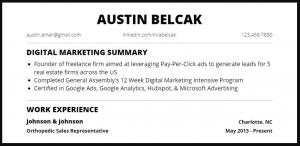
10. Emphasize Your Related Abilities.
It is standard practice to include a skills section on your resume, which highlights the experience that is relevant to the job.
You may add languages you speak, technological skills you possess, and courses you have completed. For those who lack relevant work experience, you may also finish specific training courses, which you can discover on LinkedIn and elsewhere, appropriate to the position you are applying for and include the courses in this area.
11. Be Succinct In Your Wording
Some recruiters review as many as 500 applications to fill a single job, so they want to see your achievements, abilities, and experiences in the fewest number of words as possible on your resume. Bullet points and concise wording may help you demonstrate your communication abilities while emphasizing your specialty areas.
12. Make Use Of A Professional-Looking Typeface.
Because employers only have a limited amount of time to examine your resume, it should be as concise and straightforward to read as possible. It would help if you chose a clear, uncluttered typeface such as Arial or Times New Roman. Maintain a font size between 10 and 12 points on your document. Choosing a clear, legible font can assist in elevating the appearance of your resume and make it seem more professional. By eliminating unnecessary white space from your resume, you make it simpler for the resume reader to concentrate only on the substance of your Resume Template rather than the empty spaces.
13. Construct A Straightforward Education Part.
Having a well-organized education section on your resume is critical, mainly if you are a recent college graduate or have little job experience under your belt. Your education section should be very comprehensive to emphasize all of your school-related achievements if you lack professional experience but have a strong track record in other areas of your life. For those who have more than a few years of professional experience, it is acceptable to keep the education part of their resume brief and to the point.
14. Select The Most Appropriate Resume Design.
The most challenging portion is over. You’ve completed your CV and are feeling optimistic about your chances of landing an interview. After then, it’s time to take a step back and think about the design of your resume. Your resume style may need to be modified to meet the hiring manager’s needs, depending on the industry you work in or the position you want.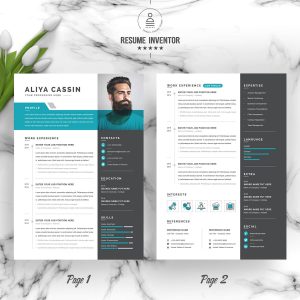
15. Proofread and Modify
Several rounds of editing should perform on your resume before sending it out to guarantee no spelling or grammatical mistakes. While there are various proofreading applications and tools available, it is also beneficial to have trustworthy friends or coworkers check your resume before submitting it. Prepare yourself by reading your resume and cover letter many times at various times of the day so that everything seems to be in proper working order
16. Do not use the phrase “References are available upon request.”
You will give references if requested, therefore include references on a resume or writing “references available upon request” is a waste of space. Employers consider this to be a beginner’s error. Therefore feel free to delete this part altogether.
17. Create A PDF Version Of Your Resume.
If you’re creating your resume with Word, you’re likely storing it in the doc format. It is, however, recommended that you save it as a PDF file as well. Because PDFs maintain their layout regardless of how they are read, PDFs are the most reliable format for sending your application electronically. Regarding IT resume tips, this is a useful one to have on hand and refer to regularly.
18. Have a second person go through your resume.
Even if you believe your resume needs improvement, it is a good idea to get a second and third view of it. A third party will be in a better position to assess the overall quality of your resume and offer suitable recommendations since we are typically oblivious to our errors or ways of thinking.
19. Clear Focus
Your CV must have a distinct point of emphasis. If you stated that you were studying theater one year and worked as an accountant the following year, it would create a bad image. Make sure that all of the material you want to provide contributes to creating a cohesive picture. Employers like individuals who are self-assured.
20. The Use of Plagiarism Detection Software
Plagiarism checking tools are software programs used in various fields to determine whether or not a text is original.
You may be shocked to learn that plagiarism is a problem. As a result, before submitting your resume, you must ensure that it does not include any instances of plagiarism. Professional resume plagiarism detecting tool such as Editpad.org is readily available on the internet to check plagiarism in your resume.
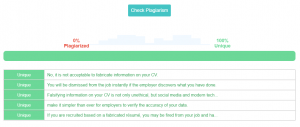 A user-friendly design and simple choices are provided. The program is speedy at identifying plagiarism since it compares text sets against the biggest database of resumes available on the web.
A user-friendly design and simple choices are provided. The program is speedy at identifying plagiarism since it compares text sets against the biggest database of resumes available on the web.
Is It OK To Fabricate Information On Your Resume? No, it is not acceptable to fabricate information on your CV. You will be dismissed from the job instantly if the employer discovers what you have done. Falsifying information on your CV is not only unethical, but social media and modern technologies make it simpler than ever for employers to verify the accuracy of your data.
If you are recruited based on a fabricated résumé, you may be fired from your job and harmed your professional networking prospects.
Conclusion
To create a good CV, you must personalize it and make it unique. Please follow the steps outlined above. If you still need assistance, you may want to examine a few more examples and templates relevant to your sector or desired job.
Thank You!
Read Others Articles
21+ Best Contemporary (New Styles) Resume CV Templates (For 2020/2021) 5 Must-Have Skills For Your Nursing Resume
5 Must-Have Skills For Your Nursing Resume
How to Write A Skills Based Resume in 5 Steps
